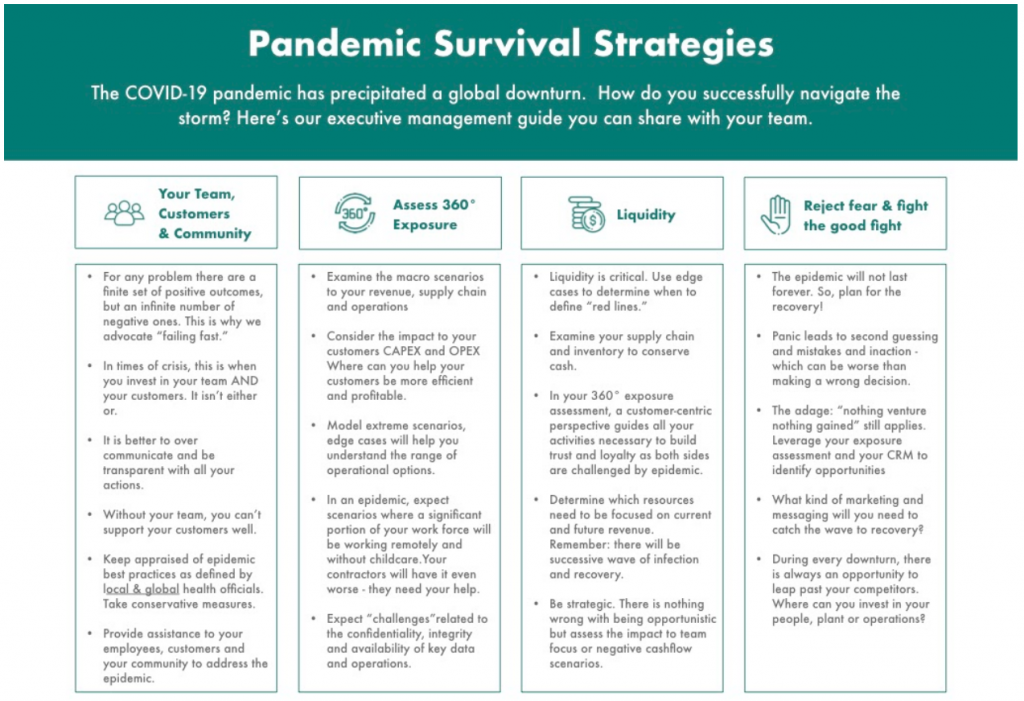March 24, 2020
Pandemic Survival Strategies: A leadership guide for organizations wanting to weather the COVID-19 storm

COVID-19 is impacting the global economy
Both of us witnessed the impacts of the Severe Acute Respiratory Syndrome (SARS) outbreak in 2003, though from different perspectives. Jason was in East Asia and witnessed the fear and market collapse that happened then. He drafted this initial version of the guide. David meanwhile was in the U.S. with the Centers for Disease Control’s Bioterrorism Preparedness and Response Program and saw the outbreak from a public health emergency response perspective.
Fast forward to 2020 and now we have a global pandemic with effects that will change the way we work, live, and interact for some time to come. At the time of writing, some 20% of the world’s population find themselves under lockdown and the economic powerhouses of Europe and North America grapple with the realization that they are now the epicenter of the unfolding COVID-19 pandemic. The prospect of global economic depression looms.
While the pandemic is serious, however, we can and will get through this. This article is about more than business continuity planning for organizations, be they in tech or NGOs, that seeks to provide value to people. This guide is about good leadership in turbulent environments. If we act smart and if we are willing to invest in each other, we may all come out of this situation faster — and potentially stronger.
1. Your Team, Customers & Community
Let’s start by looking at the factors that have to do with your team, your customers and your community. Remember that these three groups do not exist in isolation (even when we are practicing social distancing) but are interconnected. This is why it’s important to remember that for every problem there exists a finite set of positive outcomes but an infinite number of negative ones. This is why we advocate “failing fast.” Agility and flexibility are key.
In times of crisis, this is when you invest in your team AND in your customers. It isn’t an either/or zero-sum game. After all, without your team, you can’t support your customers well. And without your customers — well, sooner or later you won’t have your team anymore. Give them all the support and leeway you can. Perhaps your employees will also be looking after their children during this time, which may also include being responsible for their schooling. Keep in mind your contractors, who will have it even worse. They will all require your help, your understanding, and your patience at this time. Activating the creativity of your employees to find solutions that work for them and you is your ace in the hole now. To do that you need effective and open communication.
Effective and open communication between all parties is of the utmost importance when transitioning to the work-from-home reality of social distancing. With everyone spread out, take nothing for granted in terms of making sure that everyone knows what is going on, and why. It is better to over-communicate and be transparent with your actions.
In terms of your responsibility to your team and community, stay up to date with and abide by the best practices with regard to the pandemic as defined by local and global health officials. Adopt conservative measures rather than taking unnecessary risks. If you look at the countries affected earlier by the pandemic, we are looking at a minimum of six months before the outbreak is brought under control. Presumptions of “two weeks and we’ll be back” are unlikely given that some nations have as yet been unwilling to recommend a lockdown. Provide whatever material (such as personal protective equipment) or logistical assistance you can to your employees, your customers, and your community.
2. Assess Your 360-Degree Exposure
To navigate the storm, you’re going to need to be as open-eyed as you can regarding your company’s exposure and where the greatest risks or liabilities are likely to come from. Examine the macro scenarios to your revenue, your supply chain, and your operations. This exposure analysis needs to expand beyond your company. You want to consider the impact of the crisis on your customers’ capital and operational expenditure as well. These are your market opportunities. How can your company help your customers be more efficient and profitable?
Plan for the worse by modeling the edge cases — the severity and duration of ongoing lockdowns, for instance, or the effectiveness (or not) of government attempts to keep the markets afloat. Use such extreme scenarios as a way to help you understand the range of operational options open to you. At the very least, as we’ve already mentioned, you can expect scenarios where a significant portion of your workforce will be working remotely. In preparation, you need to consider how you will ensure the confidentiality, integrity, and availability of key data and communications between employees. You will quickly need to invest in VPN connections, hardware and software keys necessary to secure your communications in such a way that you don’t lose your trade secrets.
3. Consider Your Liquidity
Liquidity is critical. Liquidity gives you the flexibility to respond in the rapidly changing situations as we endure the recovery and resurgence of COVID-19 cases in the months ahead. As with your exposure modeling, look at edge cases to determine when to define “red lines.” Undertake a thorough examination of your human resources, supply chain and inventory in order to conserve cash.
This is, again, also an area where having a customer-centric perspective is of vital importance. In your 360-degree exposure assessment, such a perspective should guide all your activities necessary to build trust and loyalty as both sides seek to meet the challenges posed by COVID-19. We reiterate: a zero-sum, I-win-you-lose mentality is a failing strategy. Look for “win-win” with your partners. You, your customers and your supply chain partners will rely on each other to keep things moving and maintain liquidity.
Make decisions to determine which of your resources need to be allocated on current AND future revenue. It’s important to bear in mind that as the pandemic runs its course there will be successive waves of infection and recovery. Make your plans accordingly and be strategic as you do so. Unexpected opportunities may arise and there is nothing wrong with pursuing a chance that comes your way. But make a judgment call on what impact it could have on team focus — or the chance of a negative cash flow scenario.
4. Fight the Good Fight (aka, Reject Paralyzing Fear)
Even the worst storm blows itself out eventually. The COVID-19 pandemic will not last forever, so plan for the recovery!
As Jason notes, did you know the word for crisis (危機, weiji) in Mandarin shares a common character with the word for “opportunity” (機會, jihui)? That character (機, ji) can be translated as a “turning point” or “crucial moment.”
As David also notes: It is the choices that we make as humans, choices in how we respond to the turbulence presented to us, how we learn + do + adapt to changing circumstances, and how we partner with others that can help move our world forward in a positive direction that ultimately shapes the future.
Choices in the turning points before us matter. Remember: “Fear is the mind-killer.” Stress-induced panic will lead you to second-guess your intuition and your judgment, bringing mistakes or what can be even worse, the paralysis of inaction. It’s often better to make a wrong decision than no decision at all. One adage to consider: FAIL isn’t failing, it’s the “First Attempt at Iterative Learning.”
The world is changing before us. As leaders, we don’t want you to be entirely risk-averse during this period. As leaders, you are hired to be risk-accepting and drive opportunity, right? The adage “nothing ventured, nothing gained” still applies. Leverage your exposure assessment and your customer relationship management to identify possible opportunities.
In the same vein, consider what kind of marketing and messaging you will need to catch the wave to recovery. Many businesses have started to do this already, so much so in fact that companies contacting their customers to tell them how they are handling the coronavirus crisis has become something of a source of online humor. If you can find something original or unique to say, this is an opportunity for you!
During every downturn, there is always an opportunity to leapfrog competitors. Ask yourself: Where can you invest in your people, your plant or your operations?
Jason Wang is a Guest Author and David Bray, PhD is the inaugural Director of Atlantic Council GeoTech Center

Be Benevolent,
Be Bold, and
Be Brave in our challenging times.
The COVID-19 pandemic will take some months to resolve and potentially longer. The world will certainly be changed by it. So treat it as an opportunity. We believe these suggestions offer the best chance to ensure that your startup will rise to meet the challenges of this crucial moment.
We all can lead. Positive “change agents” — individuals willing to work across sectors and nations to help illuminate better ways through the shared turbulence we are experiencing — are needed now more than ever. We hope you’ll join the good fight against the COVID-19 disruptions alongside us.
